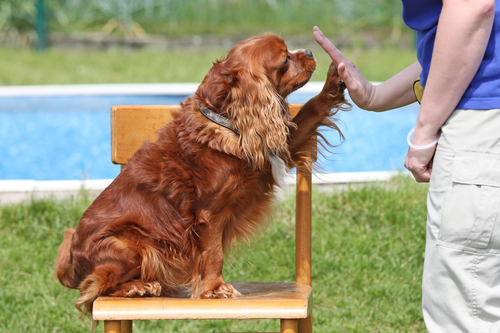How to Properly Train a Cocker Spaniel

If you properly train a Cocker Spaniel, you’ll be providing them with the mental and physical stimulation they need. On top of this, you’ll be getting a well-behaved dog that can live with other members of the family and with other animals.
The Cocker is a very easy dog to train because it really wants to be liked. It’s easy to teach them all kinds of tricks, as well as how to behave properly. In this article, we’ll show you how to properly train a Cocker Spaniel.
Tips on how to train a Cocker Spaniel
To train a Cocker Spaniel, make sure they understand that they’re taking classes and that you want them to do something. Behavior is shaped by repetition, consistency, and using rewards such as treats, praise, or caresses. Speak to the dog clearly, slowly, and keep the commands clear and simple – one word and preferably one syllable.
Train the Cocker every day, otherwise they may forget what they’ve already learned. However, keep the sessions short – between 10 and 15 minutes – so that they don’t get bored and lose interest.
Cocker Spaniels need daily exercise to vent their energy and enthusiasm. For this reason, it’s advisable to do long walks three times a day, along with good long sessions of play. In this way, they’ll be calmer at home and more willing to train than to play.
This breed of dog is very sensitive, so try not to intimidate or correct it harshly, because this can be counterproductive and cause insecurity. Don’t be impatient or frustrated either, because Cockers are eager to please. They may give up if they think they’re not meeting your expectations.
Be nice and lean more toward rewards than punishments. Positive reinforcement is always more effective than punishment.
Basic education
In addition to the usual commands to teach a dog, that is; Sit, come, lie down and stay, it’s also important to teach your Cocker to do their “necessities” in the correct place, and to walk correctly on a leash.
Choose a spot for your Cocker to relieve himself, be it a newspaper, a box, or the corner of the garden. The first time your Cocker enters the house, take them to the place where you want them to relieve themself. This will give them an olfactory memory, and the first thing they’ll probably want to do is mark their territory.
Go with your dog until they do their business and immediately give them a treat. Give them a prize whenever they do it where you want them to. If they do it somewhere else, then just take them to the place they’ve done it.
Show them it (without rubbing their nose in it, which is canine abuse, and say NO! with a firm voice. Then take them to the place where they should have done it and leave them there for 10 to 15 minutes on their own.
Don’t use this process as a punishment for other things or the dog will get confused. It’s a good idea to clean the place frequently, change the newspaper or remove the excrement from the garden. If the dog finds the place unpleasant, it won’t go.
Walking on a leash
Another aspect that the Cocker must learn is to walk on a leash. Firstly, because you’ll avoid accidents, and, secondly, because it may be mandatory in your country for dogs to be leashed on public roads, in garden areas, in parks, and in neighboring communities.
To get the dog used to wearing a leash, first introduce the collar (which should always be worn, along with a tag, for identification purposes). To get the Cocker used to the collar, it’s best for them to wear it while you feed it or play with it. They’ll try to remove it at first, but don’t take it off until they’re comfortable and don’t mind wearing it.
Once the dog is comfortable wearing the collar, attach the leash to it, and allow them to drag it around the house until they’re used to it. Then grab it by one end and take your dog for a walk. On the walk, the Cocker must learn to walk next to their owner.
If the dog pulls on the leash or sits down, stop the walk immediately. However, when they obey, call them and praise them, and start walking again when they’re by your side.
All cited sources were thoroughly reviewed by our team to ensure their quality, reliability, currency, and validity. The bibliography of this article was considered reliable and of academic or scientific accuracy.
- Asociación Internacional de Consultores de Conducta Animal. (2019) Manual de entrenamiento canino. IAABC:Chile. Recuperado el 11 de febrero de 2022, disponible en: https://m.iaabc.org/docs/espanol/IAABCManual_digitalv120919.pdf

